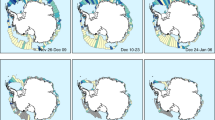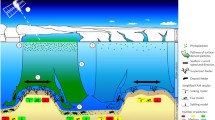Abstract
The contribution of faecal pellet (FP) production by zooplankton to the downward flux of particulate organic carbon (POC) can vary from <1 % to more than 90 % of total POC. This results from varying degrees of interception and consumption, and hence recycling, of FPs by zooplankton in the upper mixed layers, and the active transport of FP to depth via diel vertical migration (VM) of zooplankton. During mid-summer at high latitudes, synchronised diel VM ceases, but individual zooplankton may continue to make forays into and out of the surface layers. This study considers the relative importance of different VM behaviours on FP export at high latitudes. We focussed on copepods and parameterised an individual-based model using empirical measures of phytoplankton vertical distribution and the rate of FP production, as a function of food availability. FP production was estimated under three different behaviours common to high-latitude environments (1) no VM, (2) foray-type behaviour and (3) synchronised diel VM. Simulations were also made of how each of these behaviours would be observed by an acoustic Doppler current profiler (ADCP). The model found that the type of copepod behaviour made a substantial difference to the level of FP export to depth. In the absence of VM, all FPs were produced above 50 m, where the probability of eventual export to depth was low. In foray-type scenarios, FP production occurred between 0 and 80 m, although the majority occurred between 30 and 70 m depth. Greatest FP production in the deeper layers (>70 m) occurred when diel VM took place. Simulated ADCP vertical velocity fields from the foray-type scenario resembled field observations, particularly with regard to the occurrence of positive anomalies in deeper waters and negative anomalies in shallower waters. The model illustrates that active vertical flux of zooplankton FP can occur at high latitudes even when no synchronised VM is taking place.








Similar content being viewed by others
References
Arrigo KR, van Dijken GL, Bushinsky S (2008) Primary production in the Southern Ocean, 1997–2006. J Geophys Res 113:C08004
Atkinson A, Shreeve RS, Pakhomov EA, Priddle J, Blight SP, Ward P (1996) Zooplankton response to a phytoplankton bloom near South Georgia, Antarctica. Mar Ecol Prog Ser 144:195–210
Ayukai T, Hattori H (1992) Production and downward flux of zooplankton fecal pellets in the anticyclonic gyre off Shikoku, Japan. Oceanol Acta 15:163–172
Berge J, Cottier F, Last KS, Varpe O, Leu E, Soreide J, Eiane K, FalkPetersen S, Willis K, Nygard H, Vogedes D, Griffiths C, Johnsen G, Lorentzen D, Brierley AS (2009) Diel vertical migration of Arctic zooplankton during the polar night. Biol Lett 5:69–72
Blachowiak-Samolyk K, Kwasniewski S, Richardson K, Dmoch K, Hansen E, Hop H, Falk-Petersen S, Mouritsen LT (2006) Arctic zooplankton do not perform diel vertical migration (DVM) during periods of midnight sun. Mar Ecol Prog Ser 308:101–116
Buesseler KO (1998) The decoupling of production and particulate export in the surface ocean. Glob Biogeochem Cycles 12:297–310
Buesseler KO, Boyd PW (2009) Shedding light on processes that control particle export and flux attenuation in the twilight zone of the open ocean. Limnol Oceanogr 54:1210–1232
Carroll ML, Miquel JC, Fowler SW (1998) Seasonal patterns and depth-specific trends of zooplankton fecal pellet fluxes in the Northwestern Mediterranean Sea. Deep-Sea Res I 45:1303–1318
Cohen JH, Forward RB Jr (2009) Zooplankton diel vertical migration—a review of proximate control. In: Gibson RN, Atkinson RJA, Gordon JDM (eds) Oceanography and marine biology: an annual review, vol 47. CRC Press, Boca Raton, pp 77–149
Cottier FR, Tarling GA, Wold A, FalkPetersen S (2006) Unsynchronized and synchronized vertical migration of zooplankton in a high arctic fjord. Limnol Oceanogr 51:2586–2599
Dagg MJ, Frost BW, Walser WE (1989) Copepod diel migration, feeding and the vertical flux of pheopigments. Limnol Oceanogr 34:1062–1071
Dagg MJ, Frost BW, Newton JA (1997) Vertical migration and feeding behavior of Calanus pacificus females during a phytoplankton bloom in Dabob Bay, U.S. Limnol Oceanogr 42:974–980
Dagg MJ, Urbanrich J, Peterson JO (2003) The potential contribution of fecal pellets from large copepods to the flux of biogenic silica and particulate organic carbon in the Antarctic Polar Front region near 170°W. Deep-Sea Res II 50:675–691
Dale T, Kaartvedt S (2000) Diel patterns in stage-specific vertical migration of Calanus finmarchicus in habitats with midnight sun. ICES J Mar Sci 57:1800–1818
Dam HG, Peterson WT (1988) The effect of temperature on the gut clearance rate constant of planktonic copepods. J Exp Mar Biol Ecol 123:1–14
Ellis SG, Small LF (1989) Comparison of gut evacuation rates of feeding and non-feeding Calanus marshallae. Mar Biol 103:175–181
Fischer J, Visbeck M (1993) Seasonal variation of the daily zooplankton migration in the Greenland Sea. Deep-Sea Res I 40:1547–1557
Frost BW (1988) Variability and possible adaptive significance of diel vertical migration in Calanus pacificus, a planktonic marine copepod. Bull Mar Sci 43:675–694
Gauld DT (1953) Diurnal variation in the grazing of planktonic copepods. J Mar Biol Assoc UK 31:461–474
Greenlaw CF (1979) Acoustical estimate of zooplankton populations. Limnol Oceanogr 24:226–242
Hardy AC, Bainbridge R (1954) Experimental observations on the vertical migrations of planktonic animals. J Mar Biol Assoc UK 33:409–448
Hassett RP, Blades-Eckelbarger P (1995) Diel changes in gut-cell morphology and digestive activity of the marine copepod Acartia tonsa. Mar Biol 124:59–69
Head EJH, Wang R, Conover RJ (1984) Comparison of diurnal feeding rhythms in Temora longicornis and Centropages hamatus with digestive enzyme activity. J Plankton Res 6:543–551
Hirche HJ (1987) Temperature and plankton 2. Effect of respiration and swimming activity in copepods from the Greenland Sea. Mar Biol 94:347–356
Hirst AG, Bunker AJ (2003) Growth of marine planktonic copepods: global rates and patterns in relation to chlorophyll a, temperature, and body weight. Limnol Oceanogr 48:1988–2010
Huskin I, Viesca L, Anadon R (2004) Particle flux in the Subtropical Atlantic near the Azores: influence of mesozooplankton. J Plankton Res 26:403–415
Kiørboe T, Mohlenberg F, Riisgard HU (1985) In situ feeding rates of planktonic copepods—a comparison of 4 methods. J Exp Mar Biol Ecol 88:67–81
Le Quere C, Rodenbeck C, Buitenhuis ET, Conway TJ, Langenfelds R, Gomez A, Labuschagne C, Ramonet M, Nakazawa T, Metzl N, Gillett N, Heimann M (2007) Saturation of the Southern Ocean CO2 sink due to recent climate change. Science 316:1735–1738
Leising AW, Pierson JJ, Cary S, Frost BW (2005) Copepod foraging and predation risk within the surface layer during night-time feeding forays. J Plankton Res 27:987–1001
Longhurst A (1998) Ecological geography of the sea. Academic Press, London
Longhurst AR, Harrison WG (1988) Vertical nitrogen flux from the oceanic photic zone by diel migrant zooplankton and nekton. Deep-Sea Res A 35:881–889
Lukjanova WS (1940) On the maximum velocities of marine plankters. Dokl Akad Nauk SSSR 28:641–644
Mackas D, Bohrer R (1976) Fluorescence analysis of zooplankton gut contents and an investigation of diel feeding patterns. J Exp Mar Biol Ecol 25:77–85
Mackas DL, Burns KE (1986) Post-starvation feeding and swimming activity in Calanus pacificus and Metridia pacifica. Limnol Oceanogr 31:383–392
Mauchline J (1998) The biology of calanoid copepods, vol 33. Academic Press, San Diego
Noji TT (1991) The influence of macrozooplankton on vertical particulate flux. Sarsia 76:1–9
Ohman MD (1987) Energy sources for recruitment of the sub-Antarctic copepod Neocalanus tonsus. Limnol Oceanogr 32:1317–1330
Pakhomov EA, Verheye HM, Atkinson A, Laubscher RK, TauntonClark J (1997) Structure and grazing impact of the mesozooplankton community during late summer 1994 near South Georgia, Antarctica. Polar Biol 18:180–192
Pearre S (1973) Vertical migration and feeding in Sagitta elegans (Verrill). Ecology 54:300–314
Pearre S (1979) Problems of detection and interpretation of vertical migration. J Plankton Res 1:20–44
Pearre S (2003) Eat and run? The hunger/satiation hypothesis in vertical migration: history, evidence and consequences. Biol Rev 78:1–79
Perovich DK (2011) The changing Arctic sea ice cover. Oceanography 24:162–173
Pierson JJ, Leising AW, Halsband-Lenk C, Ferm N (2005) Vertical distribution and abundance of Calanus pacificus and Pseudocalanus newmani in relation to chlorophyll a concentrations in Dabob Bay, Washington. Prog Oceanogr 67:349–365
Pleuddemann AJ, Pinkel R (1989) Characterization of the patterns of diel migration using a Doppler sonar. Deep-Sea Res 36:509–530
Runge JA (1981) Egg production of Calanus pacificus Brodsky and its relationship to seasonal changes in phytoplankton availability. Ph.D. thesis, University of Washington
Schnetzer A, Steinberg DK (2002) Active transport of particulate organic carbon and nitrogen by vertically migrating zooplankton in the Sargasso Sea. Mar Ecol Prog Ser 234:71–84
Smayda TJ (1969) Some measurements of the sinking rate of fecal pellets. Limnol Oceanogr 14:621–625
Smith SL, Lane PVZ (1988) Grazing of the spring diatom bloom in the New York Bight by the calanoid copepods Calanus finmarchicus, Metridia lucens and Centropages typicus. Cont Shelf Res 8:485–509
Steinberg DK, Carlson CA, Bates NR, Goldthwait SA, Madin LP, Michaels AF (2000) Zooplankton vertical migration and the active transport of dissolved organic and inorganic carbon in the Sargasso Sea. Deep-Sea Res I 47:137–158
Tarling GA, Johnson ML (2006) Satiation gives krill that sinking feeling. Curr Biol 16:83–84
Tarling GA, Jarvis T, Emsley SM, Matthews JBL (2002) Midnight sinking behaviour in Calanus finmarchicus: a response to satiation or krill predation? Mar Ecol Prog Ser 240:183–194
Timonin AG, Arashkevich EG, Drits AV, Semenova TN (1992) Zooplankton dynamics in the northern Benguela ecosystem, with special reference to the copepod Calanoides carinatus. S Afr J Mar Sci 12:545–560
Turner JT (2002) Zooplankton fecal pellets, marine snow and sinking phytoplankton blooms. Aquat Microb Ecol 27:57–102
Wallace MI, Cottier FR, Berge J, Tarling GA, Griffiths C, Brierley AS (2010) Comparison of zooplankton vertical migration in an ice-free and a seasonally ice-covered Arctic fjord: an insight into the influence of sea ice cover on zooplankton behavior. Limnol Oceanogr 55:831–845
Wang R, Conover RJ (1986) Dynamics of gut pigment in the copepod Temora longicornisand the determination of in situ grazing rates. Limnol Oceanogr 31:867–877
Wassmann P (2011) Arctic marine ecosystems in an era of rapid climate change. Prog Oceanogr 90:1–17
Wexels-Riser C, Reigstad M, Wassmann P, Arashkevich E, Falk-Petersen S (2007) Export or retention? Copepod abundance, faecal pellet production and vertical flux in the marginal ice zone through snap shots from the northern Barents Sea. Polar Biol 30:719–730
Wexels-Riser C, Wassmann P, Reigstad M, Seuthe L (2008) Vertical flux regulation by zooplankton in the northern Barents Sea during Arctic spring. Deep-Sea Res II 55:2320–2329
Wilson SE, Steinberg DK, Buesseler KO (2008) Changes in fecal pellet characteristics with depth as indicators of zooplankton repackaging of particles in the mesopelagic zone of the subtropical and subarctic North Pacific Ocean. Deep-Sea Res II 55:1636–1647
Acknowledgments
The analysis was funded under a Natural Environment Research Council (NERC) Strategic Ocean Funding Initiative (SOFI) grant (NE/F012381/1) to Andrew S. Brierley, Geraint A. Tarling and Finlo R. Cottier, in partnership with Jørgen Berge at the University of Norway in Svalbard (UNIS). GAT was further supported by the Ecosystems Core programme at British Antarctic Survey, Natural Environment Research Council. FRC was also further supported through the Natural Environment Research Council (NERC) grant NE/H012524/1.
Author information
Authors and Affiliations
Corresponding author
Rights and permissions
About this article
Cite this article
Wallace, M.I., Cottier, F.R., Brierley, A.S. et al. Modelling the influence of copepod behaviour on faecal pellet export at high latitudes. Polar Biol 36, 579–592 (2013). https://doi.org/10.1007/s00300-013-1287-7
Received:
Revised:
Accepted:
Published:
Issue Date:
DOI: https://doi.org/10.1007/s00300-013-1287-7




